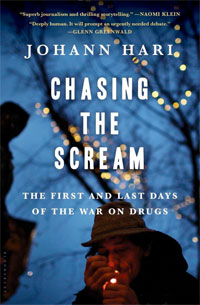Portugal Cut Addiction Rates in Half by Connecting Drug Users with Communities Instead of Jailing Them
CONFLICT RESOLUTION - MEDIATION, EUROPE, JUSTICE, HEALTH, 30 Apr 2018
Eighteen years ago, the Portuguese had one of the worst drug problems in Europe. So they decriminalized drugs, took money out of prisons, put it into holistic rehabilitation, and found that human connection is the antidote to addiction.
It is now one hundred years since drugs were first banned—and all through this long century of waging war on drugs, we have been told a story about addiction by our teachers and by our governments. This story is so deeply ingrained in our minds that we take it for granted: There are strong chemical hooks in these drugs, so if we stopped on day twenty-one, our bodies would need the chemical. We would have a ferocious craving. We would be addicted. That’s what addiction means.
This theory was first established, in part, through rat experiments—ones that were injected into the American psyche in the 1980s, in a famous advertisement by the Partnership for a Drug-Free America. You may remember it. The experiment is simple. Put a rat in a cage, alone, with two water bottles. One is just water. The other is water laced with heroin or cocaine. Almost every time you run this experiment, the rat will become obsessed with the drugged water, and keep coming back for more and more, until it kills itself.
The ad explains: “Only one drug is so addictive, nine out of ten laboratory rats will use it. And use it. And use it. Until dead. It’s called cocaine. And it can do the same thing to you.”
httpv://www.youtube.com/watch?v=7kS72J5Nlm8
But in the 1970s, a professor of Psychology in Vancouver called Bruce Alexander noticed something odd about this experiment. The rat is put in the cage all alone. It has nothing to do but take the drugs. What would happen, he wondered, if we tried this differently?
So Professor Alexander built Rat Park. It is a lush cage where the rats would have colored balls and the best rat-food and tunnels to scamper down and plenty of friends: everything a rat about town could want. What, Alexander wanted to know, will happen then?
In Rat Park, all the rats obviously tried both water bottles, because they didn’t know what was in them. But what happened next was startling.

This article is adapted from Chasing the Scream: The First and Last Day of the War on Drugs by Johann Hari, 2015.
The rats with good lives didn’t like the drugged water. They mostly shunned it, consuming less than a quarter of the drugs the isolated rats used. None of them died. While all the rats who were alone and unhappy became heavy users, none of the rats who had a happy environment did.
At first, I thought this was merely a quirk of rats, until I discovered that there was—at the same time as the Rat Park experiment—a helpful human equivalent taking place. It was called the Vietnam War. Time magazine reported using heroin was “as common as chewing gum” among U.S. soldiers, and there is solid evidence to back this up: some 20 percent of U.S. soldiers had become addicted to heroin there, according to a study published in the Archives of General Psychiatry.
Many people were understandably terrified; they believed a huge number of addicts were about to head home when the war ended.
But in fact some 95 percent of the addicted soldiers—according to the same study—simply stopped. Very few had rehab. They shifted from a terrifying cage back to a pleasant one, so didn’t want the drug any more.
Professor Alexander argues this discovery is a profound challenge both to the right-wing view that addiction is a moral failing caused by too much hedonistic partying, and the liberal view that addiction is a disease taking place in a chemically hijacked brain. In fact, he argues, addiction is an adaptation. It’s not you. It’s your cage.
Rats in the Park
After the first phase of Rat Park, Professor Alexander then took this test further. He reran the early experiments, where the rats were left alone, and became compulsive users of the drug. He let them use for 57 days—if anything can hook you, it’s that.
Then he took them out of isolation, and placed them in Rat Park. He wanted to know, if you fall into that state of addiction, is your brain hijacked, so you can’t recover? Do the drugs take you over? What happened is—again—striking. The rats seemed to have a few twitches of withdrawal, but they soon stopped their heavy use, and went back to having a normal life. The good cage saved them.
If you fall into that state of addiction, is your brain hijacked, so you can’t recover?
When I first learned about this, I was puzzled. How can this be? This new theory is such a radical assault on what we have been told that it felt like it could not be true. But the more scientists I interviewed, and the more I looked at their studies, the more I discovered things that don’t seem to make sense—unless you take account of this new approach.
Here’s one example of an experiment that is happening all around you, and may well happen to you one day. If you get run over today and you break your hip, you will probably be given diamorphine, the medical name for heroin. In the hospital around you, there will be plenty of people also given heroin for long periods, for pain relief.
The heroin you will get from the doctor will have a much higher purity and potency than the heroin being used by street-addicts, who have to buy from criminals who adulterate it. So if the old theory of addiction is right—it’s the drugs that cause it; they make your body need them—then it’s obvious what should happen. Loads of people should leave the hospital and try to score smack on the streets to meet their habit.
The street-addict is like the rats in the first cage, isolated, alone, with only one source of solace to turn to.
But here’s the strange thing: It virtually never happens. As the Canadian doctor Gabor Mate was the first to explain to me, medical users just stop, despite months of use. The same drug, used for the same length of time, turns street-users into desperate addicts and leaves medical patients unaffected.
If you still believe, as I used to, that chemical hooks are what cause addiction, then this makes no sense.
But if you believe Bruce Alexander’s theory, the picture falls into place. The street-addict is like the rats in the first cage, isolated, alone, with only one source of solace to turn to. The medical patient is like the rats in the second cage. She is going home to a life where she is surrounded by the people she loves. The drug is the same, but the environment is different.
The Opposite of Addiction Is Connection
This gives us an insight that goes much deeper than the need to understand addicts.
Professor Peter Cohen argues that human beings have a deep need to bond and form connections. It’s how we get our satisfaction. If we can’t connect with each other, we will connect with anything we can find—the whirr of a roulette wheel or the prick of a syringe. He says we should stop talking about ‘addiction’ altogether, and instead call it ‘bonding.’ A heroin addict has bonded with heroin because she couldn’t bond as fully with anything else.
So the opposite of addiction is not sobriety. It is human connection.
A heroin addict has bonded with heroin because she couldn’t bond as fully with anything else.
When I learned all this, I found it slowly persuading me, but I still couldn’t shake off a nagging doubt. Are these scientists saying chemical hooks make no difference? It was explained to me—you can become addicted to gambling, and nobody thinks you inject a pack of cards into your veins. You can have all the addiction, and none of the chemical hooks. I went to a Gamblers’ Anonymous meeting in Las Vegas (with the permission of everyone present, who knew I was there to observe) and they were as plainly addicted as the cocaine and heroin addicts I have known in my life. Yet there are no chemical hooks on a craps table.
But still, surely, I asked, there is some role for the chemicals? It turns out there is an experiment which gives us the answer to this in quite precise terms, which I learned about in Richard DeGrandpre’s book The Cult of Pharmacology.
Everyone agrees cigarette smoking is one of the most addictive processes around. The chemical hooks in tobacco come from a drug inside it called nicotine. So when nicotine patches were developed in the early 1990s, there was a huge surge of optimism—cigarette smokers could get all of their chemical hooks, without the other filthy (and deadly) effects of cigarette smoking. They would be freed.
Ironically, the war on drugs actually increases all those larger drivers of addiction.
But the Office of the Surgeon General has found that just 17.7 percent of cigarette smokers are able to stop using nicotine patches. That’s not nothing. If the chemicals drive 17.7 percent of addiction, as this shows, that’s still millions of lives ruined globally. But what it reveals again is that the story we have been taught about chemical hooks is, in fact, real, only a minor part of a much bigger picture.
This has huge implications for the 100-year-old war on drugs.
This massive war—which kills people from the malls of Mexico to the streets of Liverpool—is based on the claim that we need to physically eradicate a whole array of chemicals because they hijack people’s brains and cause addiction. But if drugs aren’t the driver of addiction—if, in fact, it is disconnection that drives addiction—then this makes no sense.
Ironically, the war on drugs actually increases all those larger drivers of addiction. For example, I went to a prison in Arizona—Tent City—where inmates are detained in tiny stone isolation cages (‘The Hole’) for weeks and weeks on end to punish them for drug use. It is as close to a human recreation of the cages that guaranteed deadly addiction in rats as I can imagine. And when those prisoners get out, they will be unemployable because of their criminal record, guaranteeing they with be cut off ever more.
How Portugal Halved Drug Addiction Levels
There is an alternative. You can build a system that is designed to help drug addicts to reconnect with the world—and so leave behind their addictions.
This isn’t theoretical. It is happening. I have seen it. Nearly 15 years ago, Portugal had one of the worst drug problems in Europe, with one percent of the population addicted to heroin. They had tried a drug war, and the problem just kept getting worse.
So they decided to do something radically different. They resolved to decriminalize all drugs, and transfer all the money they used to spend on arresting and jailing drug addicts, and spend it instead on reconnecting them—to their own feelings, and to the wider society.
Decriminalization has been such a manifest success that very few people in Portugal want to go back to the old system.
The most crucial step is to get them secure housing, and subsidized jobs so they have a purpose in life, and something to get out of bed for. I watched as they are helped, in warm and welcoming clinics, to learn how to reconnect with their feelings, after years of trauma and stunning them into silence with drugs.
One group of addicts were given a loan to set up a removals firm. Suddenly, they were a group, all bonded to each other, and to the society, and responsible for each other’s care.
The results of all this are now in. An independent study by the British Journal of Criminology found that since total decriminalization, addiction has fallen, and injecting drug use is down by 50 percent. I’ll repeat that: injecting drug use is down by 50 percent.
Decriminalization has been such a manifest success that very few people in Portugal want to go back to the old system. The main campaigner against the decriminalization back in 2000 was Joao Figueira, the country’s top drug cop. He offered all the dire warnings that we would expect: more crime, more addicts. But when we sat together in Lisbon, he told me that everything he predicted had not come to pass—and he now hopes the whole world will follow Portugal’s example.
Happiness in “the Age of Loneliness”
This isn’t only relevant to addicts. It is relevant to all of us, because it forces us to think differently about ourselves. Human beings are bonding animals. We need to connect and love. The wisest sentence of the twentieth century was E.M. Forster’s: “only connect.” But we have created an environment and a culture that cut us off from connection, or offer only the parody of it offered by the Internet. The rise of addiction is a symptom of a deeper sickness in the way we live–constantly directing our gaze towards the next shiny object we should buy, rather than the human beings all around us.
The writer George Monbiot has called this “the age of loneliness.” We have created human societies where it is easier for people to become cut off from all human connections than ever before. Bruce Alexander, the creator of Rat Park, told me that for too long, we have talked exclusively about individual recovery from addiction. We need now to talk about social recovery—how we all recover, together, from the sickness of isolation that is sinking on us like a thick fog.
We need now to talk about social recovery—how we all recover, together …
But this new evidence isn’t just a challenge to us politically. It doesn’t just force us to change our minds. It forces us to change our hearts.
Loving an addict is really hard. When I looked at the addicts I love, it was always tempting to follow the tough love advice doled out by reality shows like Intervention—tell the addict to shape up, or cut them off. Their message is that an addict who won’t stop should be shunned. It’s the logic of the drug war, imported into our private lives.
But in fact, I learned, that will only deepen their addiction—and you may lose them altogether. I came home determined to tie the addicts in my life closer to me than ever—to let them know I love them unconditionally, whether they stop, or whether they can’t.
_________________________________________
This article is adapted from Chasing the Scream: The First and Last Days of the War on Drugs, by Johann Hari.
 Johann Hari is a British journalist whose work has appeared in the New York Times, Le Monde, The Guardian, The New Republic, and other publications.
Johann Hari is a British journalist whose work has appeared in the New York Times, Le Monde, The Guardian, The New Republic, and other publications.
Go to Original – yesmagazine.org
DISCLAIMER: The statements, views and opinions expressed in pieces republished here are solely those of the authors and do not necessarily represent those of TMS. In accordance with title 17 U.S.C. section 107, this material is distributed without profit to those who have expressed a prior interest in receiving the included information for research and educational purposes. TMS has no affiliation whatsoever with the originator of this article nor is TMS endorsed or sponsored by the originator. “GO TO ORIGINAL” links are provided as a convenience to our readers and allow for verification of authenticity. However, as originating pages are often updated by their originating host sites, the versions posted may not match the versions our readers view when clicking the “GO TO ORIGINAL” links. This site contains copyrighted material the use of which has not always been specifically authorized by the copyright owner. We are making such material available in our efforts to advance understanding of environmental, political, human rights, economic, democracy, scientific, and social justice issues, etc. We believe this constitutes a ‘fair use’ of any such copyrighted material as provided for in section 107 of the US Copyright Law. In accordance with Title 17 U.S.C. Section 107, the material on this site is distributed without profit to those who have expressed a prior interest in receiving the included information for research and educational purposes. For more information go to: http://www.law.cornell.edu/uscode/17/107.shtml. If you wish to use copyrighted material from this site for purposes of your own that go beyond ‘fair use’, you must obtain permission from the copyright owner.
Read more
Click here to go to the current weekly digest or pick another article:
CONFLICT RESOLUTION - MEDIATION:
- The Visionary Palestinian Peace Plan for Israel and Gaza That You’ve Never Heard of
- TFF Portfolio for True Peace in Ukraine
- President Putin Reiterates the 14 Jun 2024 Conditions for Ending the War with Ukraine
EUROPE:
- An Open Letter to German Chancellor Friedrich Merz: Security Is Indivisible--and History Matters
- EU: Ministers Propose Unprecedented Detention, Sanctions, and Stripping of Rights Based on Migration Status
- Public Broadcasters Quit Eurovision 2026 over Participation of Israel
JUSTICE:
- Int’l Court of Justice Finds Israelis Broke Law by Starving Palestinians of Gaza
- Gaza Tribunal: A Historic Statement in the Shadow of Testimony
- Bertrand Russell's Historic War Crimes Tribunal against the US in Vietnam, 1964-1967
HEALTH:
